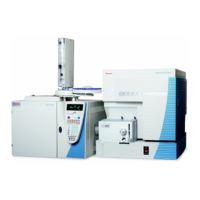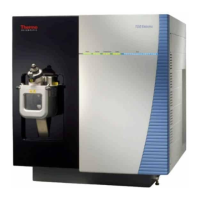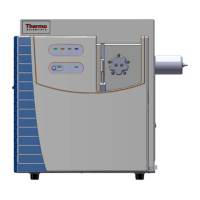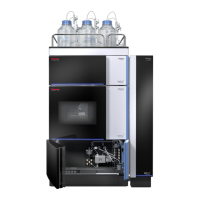7
Diagnostics and Troubleshooting
Troubleshooting
Thermo Scientific TSQ Quantum XLS Series User Guide 123
Issue: Vacuum is faulty. Possible Solutions
• A gross leak is present. Check for leaks.
• The pressure in the analyzer region of the vacuum manifold, as measured by the ion
gauge, must be below the pressures listed in Table 3 on page 55.
Linearity Issues
Linearity issues occur when a plot of intensity versus concentration of a known compound is
not linear. Poor instrument operating conditions can cause linearity problems. In addition,
certain compounds do not give a desired linear response due to chromatographic activity.
A well-maintained instrument provides good linear response over a wide range of
concentrations for most compounds. Like all instruments, however, the TSQ Quantum XLS
Series mass spectrometers have a saturation point.
Perform routine injector and column maintenance to minimize linearity problems. Usually, a
hardware fault that affects linearity shows different issues than those that might be attributed
to linearity.
Issue: Calibration plots
not sufficiently linear.
Possible causes/solutions
• High-end standards are too concentrated for the MS. Use the split injection technique to
decrease the amount of sample, or lower emission current to reduce MS sensitivity.
• The ion volume and lenses are dirty. Clean ion volume and lenses as described in
“Cleaning Ion Source Components” on page 85.
• The electron multiplier setting is incorrect. Run the tune and calibration procedure as
described in “Running Auto Tune and Calibration” on page 64.
• The injection port liner or capillary column is dirty. Change the injection port liner and
trim the capillary column.
• The capillary column stationary phase is too thin for high concentration samples. Use a
higher capacity capillary column with a thicker stationary phase, or use a split injection
technique.
• The capillary column is bad. Replace the capillary column. See “Removing and Installing
a GC Capillary Column” on page 107.

